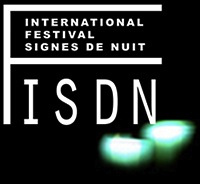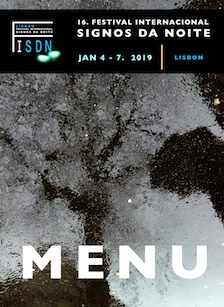 |
|
 |
The 16th International Festival
Signes de Nuit
Lisbon
16. Festival Internacional
Signos Da Noite
January 4 - 7, 2019
|
|
 |
|
|
|
|
|
|
****** |
International Competition
Documentary
# 5 |
Monday, January 7, 2019/ 3 pm
DARC, Desterro
Lisbon, Portugal
|
Vira Chudnenko |
|
|
Ines Oliveira
Portugall
2018 / 0:31:00
“The body was… unrecognisable. I didn’t see the head, I didn’t see the
arm, I didn’t see legs… I only saw the body wrapped in dirt.” Based
upon a fait-divers that stunned the country: four Rottweiler dogs at
large mauled a woman to death.
|
| |
|
Nabbin |
|

PORTUGAL PREMIER
|
Kat Tolkovsky
Czech Republic, Israel
2018 / 0:30:00
After years in Israel the filmmaker returns to Nabbin in the Czech
Republic, the place where she grew up, and to the people who
surrounded her then.
Sajat’ / Diane Lentin / France / 2018 / 0:39:00
Russia today. In its complexity, its enigma. Diane Lentin does not
claim to shed light on things. This is evidenced by the voices she
uses, as old as the famous the Journal of Astolphe de Custine in 1839.
Because above all what she is looking for, as though groping her way
around, is to see and to hear. Therefore here is a splintered film,
with slow fragments drifting like lumps of snow, on which are slowly
engraved the marks of lives, subjected to politics, but also to a
faceless melancholy.
"One must travel one's own self to know how much the reputations made
to the various peoples by travelers, often light in their judgments by
laziness of mind, affect the characters." Every individual in
particular strives to protest against the general opinion. established
with respect to the people of his country. "
This quote closes the journal of the Marquis de Custine, "Letters of
Russia" published in 1839. Custine is the enigmatic character that
accompanies Sokurov in "The Russian Ark", which appears and disappears
throughout this wandering in the Hermitage Palace in St. Petersburg,
and in the History of Russia. This film is a diary of a young
Westerner who travels this great country and its great history trying
to understand what some people are living and what some people think.
It is a look at Russia one hundred years after the Revolution and the
children who will grow there. But it's just a look.
|
| |
|
Sajat’ |
|

PORTUGAL PREMIER
|
Diane Lentin
France
2018 / 0:39:00
Russia today. In its complexity, its enigma. Diane Lentin does not
claim to shed light on things. This is evidenced by the voices she
uses, as old as the famous the Journal of Astolphe de Custine in 1839.
Because above all what she is looking for, as though groping her way
around, is to see and to hear. Therefore here is a splintered film,
with slow fragments drifting like lumps of snow, on which are slowly
engraved the marks of lives, subjected to politics, but also to a
faceless melancholy.
"One must travel one's own self to know how much the reputations made
to the various peoples by travelers, often light in their judgments by
laziness of mind, affect the characters." Every individual in
particular strives to protest against the general opinion. established
with respect to the people of his country. "
This quote closes the journal of the Marquis de Custine, "Letters of
Russia" published in 1839. Custine is the enigmatic character that
accompanies Sokurov in "The Russian Ark", which appears and disappears
throughout this wandering in the Hermitage Palace in St. Petersburg,
and in the History of Russia. This film is a diary of a young
Westerner who travels this great country and its great history trying
to understand what some people are living and what some people think.
It is a look at Russia one hundred years after the Revolution and the
children who will grow there. But it's just a look. |
| |
|
January 4 - 7 , 2019
An international jury overview the sections of short films coming from all over the world. We prefer documentaries which succeed in representing the complexity of reality and discover in a new way its sensible and perturbing aspects on the same time accentuating the ambivalent and enigmatic status of reality in avoiding sterotypes and simplifing conclusions.
|
|
|
|